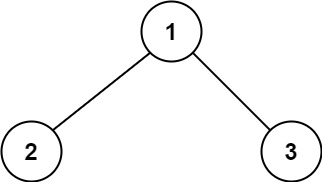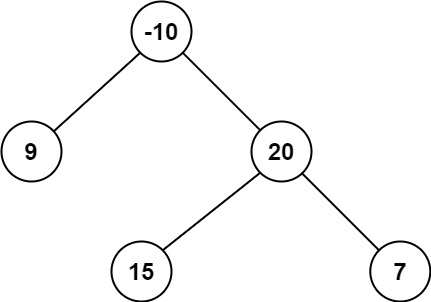路径 被定义为一条从树中任意节点出发,沿父节点-子节点连接,达到任意节点的序列。同一个节点在一条路径序列中 至多出现一次 。该路径 至少包含一个 节点,且不一定经过根节点。
路径和 是路径中各节点值的总和。
给定一个二叉树的根节点 root ,返回其 最大路径和,即所有路径上节点值之和的最大值。
示例 1:

输入:root = [1,2,3]
输出:6
解释:最优路径是 2 -> 1 -> 3 ,路径和为 2 + 1 + 3 = 6示例 2:

输入:root = [-10,9,20,null,null,15,7]
输出:42
解释:最优路径是 15 -> 20 -> 7 ,路径和为 15 + 20 + 7 = 42提示:
- 树中节点数目范围是
[1, 3 * 104] -1000 <= Node.val <= 1000
//leetcode submit region begin(Prohibit modification and deletion)
/**
* Definition for a binary tree node.
* public class TreeNode {
* int val;
* TreeNode left;
* TreeNode right;
* TreeNode() {}
* TreeNode(int val) { this.val = val; }
* TreeNode(int val, TreeNode left, TreeNode right) {
* this.val = val;
* this.left = left;
* this.right = right;
* }
* }
*/
class Solution {
private Map<TreeNode, Integer> maxPathSumMap;
private Map<TreeNode, Integer> maxPathMap;
public int maxPathSum(TreeNode root) {
maxPathSumMap = new HashMap<>();
maxPathMap = new HashMap<>();
return getMaxPathSum(root);
}
private int getMaxPathSum(TreeNode node) {
if (node == null) {
return Integer.MIN_VALUE;
}
if (maxPathSumMap.containsKey(node)) {
return maxPathSumMap.get(node);
}
int result = Integer.MIN_VALUE;
int leftMax = getMaxPathSum(node.left);
if (leftMax > result) {
result = leftMax;
}
int rightMax = getMaxPathSum(node.right);
if (rightMax > result) {
result = rightMax;
}
int mid = node.val + getMaxPath(node.left) + getMaxPath(node.right);
if (mid > result) {
result = mid;
}
maxPathSumMap.put(node, result);
return result;
}
private int getMaxPath(TreeNode node) {
if (node == null) {
return 0;
}
if (maxPathMap.containsKey(node)) {
return maxPathMap.get(node);
}
int left = getMaxPath(node.left);
int right = getMaxPath(node.right);
int result = node.val;
if (left > right && left > 0) {
result += left;
} else if (right > left && right > 0) {
result += right;
}
if (result < 0) {
result = 0;
}
maxPathMap.put(node, result);
return result;
}
}
//leetcode submit region end(Prohibit modification and deletion)


